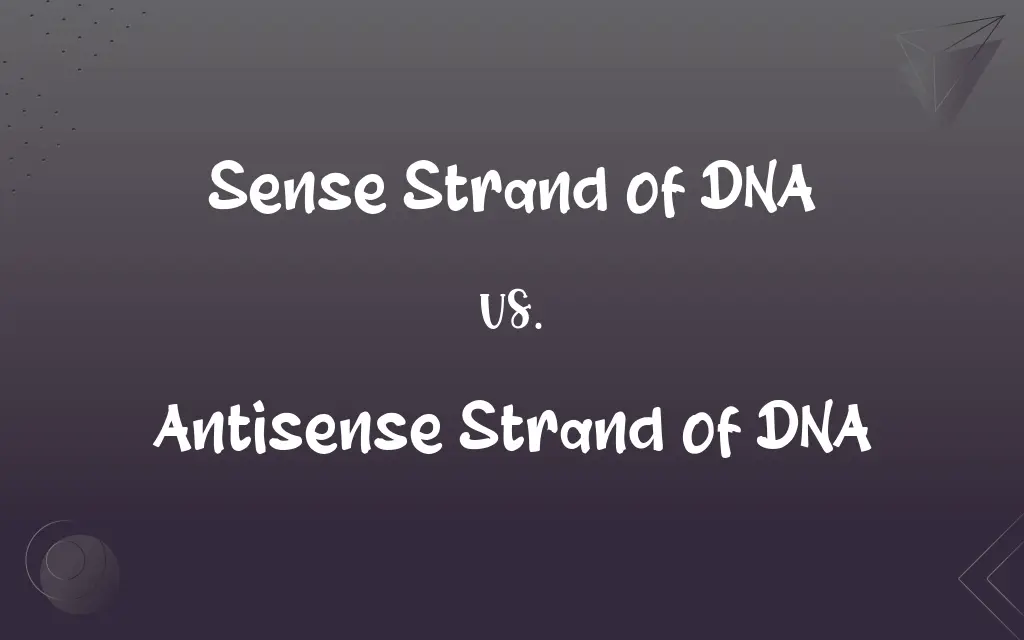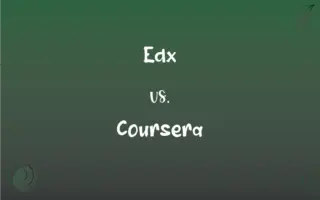Sense Strand of DNA vs. Antisense Strand of DNA: What's the Difference?
Edited by Janet White || By Harlon Moss || Updated on October 9, 2023
The sense strand of DNA has the same sequence as mRNA (except T for U), while the antisense strand serves as the template for RNA synthesis.

Key Differences
The sense strand of DNA, also termed the "coding strand," has a sequence that corresponds to the RNA sequence produced during transcription, with the exception that it contains thymine (T) instead of uracil (U). Conversely, the antisense strand of DNA, or the "template strand," is the one actually read by RNA polymerase to synthesize RNA.
In DNA's double helix, the sense strand of DNA runs from 5' to 3' end and contains the genetic code directly corresponding to the protein sequence. In contrast, the antisense strand of DNA runs in the opposite direction, from 3' to 5', and is complementary to the RNA sequence.
Importantly, the sense strand of DNA doesn't directly participate in the transcription process. Instead, the antisense strand of DNA is used by the cell's machinery to produce RNA, which subsequently undergoes translation to form proteins.
Notably, the terms "sense strand of DNA" and "antisense strand of DNA" can be somewhat confusing, as the "sense" strand is not the one used as a template during transcription. Rather, it's the "antisense" strand of DNA that plays this role.
Thus, while the sense strand of DNA possesses the genetic information in a form analogous to the mRNA sequence, the antisense strand of DNA has the essential role of acting as a direct template for RNA synthesis during the transcriptional process.
ADVERTISEMENT
Comparison Chart
Correspondence with mRNA
Matches mRNA sequence (with T for U).
Complementary to mRNA sequence.
Directionality in DNA's Double Helix
Runs 5' to 3'.
Runs 3' to 5'.
Role in Transcription
Not used as a template.
Used as a template for RNA synthesis.
Also Known As
Coding strand.
Template strand.
Base Pairing
Pairs with bases of the antisense strand.
Pairs with bases of the sense strand.
ADVERTISEMENT
Sense Strand of DNA and Antisense Strand of DNA Definitions
Sense Strand of DNA
Sense strand of DNA corresponds to the RNA sequence.
The sense strand of DNA carries the genetic code in a format similar to mRNA.
Antisense Strand of DNA
Antisense strand of DNA is also termed the template strand.
Because it's directly used in transcription, the antisense strand of DNA is often called the template strand.
Sense Strand of DNA
Sense strand of DNA is also called the coding strand.
Reading the sense strand of DNA provides an understanding of the encoded protein's amino acid sequence.
Antisense Strand of DNA
Antisense strand of DNA runs in the 3' to 5' direction.
When looking at a DNA molecule, the antisense strand of DNA is oriented from 3' to 5'.
Sense Strand of DNA
Sense strand of DNA runs from the 5' to 3' direction.
When visualizing the DNA double helix, the sense strand of DNA is typically represented as running from 5' to 3'.
Antisense Strand of DNA
Antisense strand of DNA serves as the template for RNA synthesis.
During transcription, RNA polymerase reads the antisense strand of DNA to produce mRNA.
Sense Strand of DNA
Sense strand of DNA pairs with the antisense strand.
Complementary base pairing ensures that the sense strand of DNA aligns perfectly with the antisense strand.
Antisense Strand of DNA
Antisense strand of DNA is complementary to the sense strand.
If the sense strand of DNA has an adenine base, the antisense strand will have a thymine base opposite it.
Sense Strand of DNA
Sense strand of DNA is not the template during transcription.
Despite its name, the sense strand of DNA remains inactive during RNA synthesis.
Antisense Strand of DNA
Antisense strand of DNA contains the actual sequence read during transcription.
For accurate protein synthesis, the cell relies on the antisense strand of DNA to guide RNA production.
FAQs
Which strand serves as the template for transcription?
The antisense strand of DNA serves as the template for transcription.
Which DNA strand matches the mRNA sequence?
The sense strand of DNA matches the mRNA sequence, albeit with thymine replacing uracil.
In which direction does the antisense strand run in the DNA double helix?
The antisense strand of DNA runs from 3' to 5'.
What's another name for the antisense strand?
Another name for the antisense strand of DNA is the "template strand."
Is the antisense strand the same for all genes in the genome?
No, depending on the gene's orientation, either strand can function as the antisense strand of DNA.
Can the sense strand be used for RNA synthesis if the antisense strand is damaged?
Generally, the antisense strand of DNA is the primary template. If it's damaged, mechanisms exist to repair it. The sense strand doesn't directly serve as a template for RNA synthesis.
Do all organisms have a distinction between sense and antisense strands?
Yes, all organisms that utilize DNA as their genetic material have a distinction between the sense and antisense strands of DNA due to the directionality of transcription.
Do both strands of DNA carry genetic information?
Yes, both the sense and antisense strands of DNA carry genetic information, but it's the antisense strand that's directly read to produce RNA.
In which direction does the sense strand run?
The sense strand of DNA runs from 5' to 3'.
Are both the sense and antisense strands transcribed into RNA?
Only the antisense strand of DNA is transcribed, producing a complementary RNA molecule.
What ensures that the sense strand of DNA aligns with the antisense strand?
Complementary base pairing ensures that the sense strand of DNA aligns perfectly with the antisense strand.
Is the term "antisense" exclusive to DNA?
No, "antisense" can also refer to RNA molecules that are complementary to specific messenger RNA (mRNA) sequences, inhibiting their function.
Can both strands of a DNA molecule be termed as "sense" or "antisense" simultaneously?
No, in the context of a specific gene or region, one strand will be the sense strand of DNA while the opposite strand will be the antisense strand.
How are the sense and antisense strands of DNA related to each other?
The sense and antisense strands of DNA are complementary to each other, meaning they can pair via base-pairing rules.
Why is it important to know the difference between sense and antisense strands?
Understanding the roles of sense and antisense strands of DNA is essential for comprehending gene expression, RNA synthesis, and protein production.
Does the antisense strand's sequence resemble the final protein's amino acid sequence?
No, the antisense strand of DNA is read to produce RNA, but it's the RNA sequence (which matches the sense strand, with T replaced by U) that corresponds to the protein's amino acid sequence.
If a gene mutation occurs on the sense strand, will it affect the antisense strand?
Yes, a mutation on the sense strand of DNA will cause a complementary change on the antisense strand due to base-pairing rules.
Why is the sense strand also called the coding strand?
The sense strand of DNA is called the coding strand because its sequence corresponds to the encoded protein's amino acid sequence.
Is the sense strand of DNA actively read during transcription?
No, the sense strand of DNA is not read during transcription. Instead, the antisense strand is utilized.
Does the sense strand contain uracil like RNA?
No, the sense strand of DNA contains thymine, whereas RNA contains uracil.
About Author
Written by
Harlon MossHarlon is a seasoned quality moderator and accomplished content writer for Difference Wiki. An alumnus of the prestigious University of California, he earned his degree in Computer Science. Leveraging his academic background, Harlon brings a meticulous and informed perspective to his work, ensuring content accuracy and excellence.
Edited by
Janet WhiteJanet White has been an esteemed writer and blogger for Difference Wiki. Holding a Master's degree in Science and Medical Journalism from the prestigious Boston University, she has consistently demonstrated her expertise and passion for her field. When she's not immersed in her work, Janet relishes her time exercising, delving into a good book, and cherishing moments with friends and family.































































